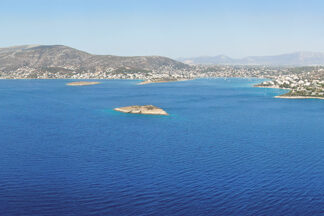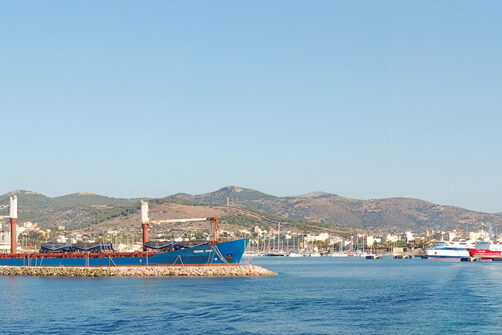
Lavrio harbour, from SE
Southeast Attiki, from Cape Sounio to the Bay of Markopoulo (including Lavrio, Keratea, and Porto Rafti), is rich in historical sites spanning from prehistoric to classical, Byzantine, and even modern periods.
Lavrio began as a cradle of metallurgical activity in the late Neolithic around 3200 BC, blossoming into one of Europe’s oldest industrial districts. By the 5th and 4th centuries BC, silver and lead extracted from its mines financed the building of Athens’s formidable trireme fleet—an investment championed by Themistocles in 483 BC that helped preserve Greek independence with the sea battle at Salamis.
At its peak, the Lavrio mines contributed roughly 25% of the Athenian state’s annual revenue, amounting to around 24 tons of silver! The region’s legacy endures today in the visible remains of ancient shafts, galleries, ore-washers, reservoirs, furnaces, and dwellings scattered throughout Lavreotiki (visit the Mineralogical Museum of Lavrion, 22920 26270).
Following centuries of decline—in which the mines lay largely abandoned during the Roman and Byzantine eras—the 19th century ushered in a revival. In 1864, mining activities resumed with the establishment of a Franco‑Italian company, later joined by the Greek Lavrion Metallurgical Company founded in 1873. The resulting industrial boom gave birth to the modern town, with company-built neoclassical architecture, worker housing, the dock and ore-loader structures, and support infrastructure such as schools and markets.
By the late 20th century, mining ceased entirely—French operations closed in 1992. Today, Lavrio embraces its heritage: sites like the Mineralogical Museum, the Technological & Cultural Park of the NTUA in former plant buildings, and Thorikos’s ancient theatre offer tangible reminders of its dual legacy—as an ancient economic powerhouse and Greece’s pioneering industrial town.
Keratea, located in the rugged inland hills of southeastern Attica, has borne human presence since the Early Helladic period (c. 2800 BC), evidenced by archaeological finds such as stone tools, ceramic fragments, and traces of fortified farmsteads. In classical antiquity, the region likely corresponded to the deme of Kephele, situated along the routes that linked Lavreotiki with Vravrona and inland Mesogeia, functioning as a modest but agriculturally vital settlement within the Athenian polis structure.
Unlike Lavrio’s industrial character, Keratea’s identity through the Byzantine and Ottoman periods was predominantly monastic and pastoral. A constellation of small rural churches and chapels—many dating from the 11th to 16th centuries—dot the landscape, including Panagia Kakaviotissa, Agios Athanasios, and Taxiarches, several of which preserve post-Byzantine frescoes of striking iconographic quality. These sites reflect not only the spiritual resilience of the local population but also Keratea’s role as a refuge during times of upheaval, including the pirate raids and Albanian incursions of the late medieval period.
Tucked into a lush coastal inlet of eastern Attica, Vravrona (ancient Brauron) was one of the most sacred sites in the Athenian religious landscape. Its origins trace back to the Bronze Age, with archaeological evidence indicating continuous habitation and cult activity as early as the 13th century BC. By the 8th century BC, Brauron had become a principal sanctuary of Artemis, the goddess of the wild, childbirth, and young girls. Central to this cult was the unique Arkteia ritual, in which pre-adolescent girls known as arktoi (“little bears”) underwent a period of seclusion and ceremonial transition into adulthood—an ancient rite of passage found nowhere else in Greece with such clarity.
The sanctuary flourished during the 6th and 5th centuries BC, closely tied to the religious reforms of Peisistratos, who elevated Brauron’s status as part of a broader Athenian identity. The site developed into an architectural complex of Doric stoas, a sacred spring, altars, and a small temple of Artemis, set against the backdrop of a fertile stream-fed valley. Votive offerings—including statues of girls, textiles, and personal items—have been unearthed in abundance, attesting to the sanctuary’s intimate, domestic character. Even in death, women remained connected to the goddess: Pausanias writes that Iphigeneia’s tomb lay here, reinforcing the mythic aura that surrounded the site.
Brauron was abandoned in the 3rd century AD (Herulian invasions), and forgotten until 20th-century excavations brought its ritual past to light. Today, the Archaeological Museum of Brauron (22990 27020) houses many of its delicate finds, while the restored stoa and ruins remain quietly nestled among fig trees and reeds.
Makronisos, a barren and rocky island located in the Aegean Sea near the coast of Attica, holds a significant yet sombre place in modern Greek history. While the island itself was largely uninhabited for centuries, its geographical position made it a natural point of control and exile. The island’s history before the 20th century remains largely peripheral, with limited evidence of sustained settlement or major historical events. However, its strategic proximity to Athens foreshadowed its later transformation into a notorious site for political repression.
During the Greek Civil War (1946–1949), Makronisos became infamous as a political prison camp, primarily used to detain and “re-educate” leftist political prisoners, including communists, socialists, and suspected sympathizers. Between 1947 and 1955, the Greek government, with tacit support from Western powers amid the Cold War tensions, converted the island into a vast internment and forced labour facility. Thousands of prisoners were subjected to harsh conditions, brutal physical punishments, and psychological torment in an attempt to break their political will and enforce ideological conformity. This period cemented Makronisos’s legacy as a symbol of repression and resistance in Greek collective memory.
The use of Makronisos as a prison camp ended in the mid-1950s, but its dark history remains deeply embedded in Greek culture and politics. In recent decades, the island has become a site of remembrance and historical inquiry, with efforts to preserve the remnants of the camps as monuments to those who suffered under authoritarian oppression. In summer, there is a local daily cruise that departs from Lavrio harbour, once a week, and visits the sites on the island.



